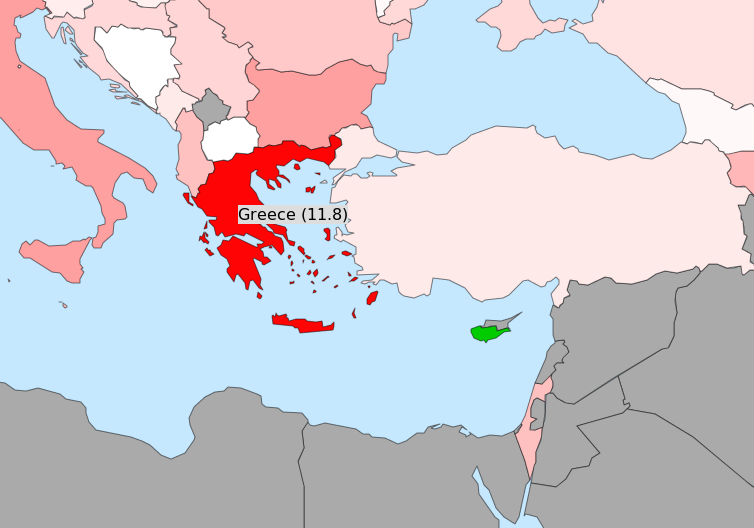I did a thing.
When juries were re-introduced in the voting procedure of the Eurovision Song Contest in 2009, this was in order to reduce the effect of voting blocs1.
It is natural to ask the following question: Did it work?
In order to answer that question for yourself, you may look at this interactive map that I created over the last two days. For each country, the average and total number of points earned from the other countries are displayed. The underlying dataset is subdivided: From 2003 until the semifinals of 2009, the points were (mainly2) determined by national televoting. Since the final of 2009, national juries and national televoting each account for 50 % of the awarded points.
Let’s for example compare the overall voting behaviour of Romania and Moldova: Two neighbouring countries with similar flag designs who like each other very much (according to their voting in the ESC at least):
Romania (top) awards 11.3 points on average to Moldova (which is basically every 12 points vote), and Moldova (bottom) even awards 11.6 points on average to Romania. The rest of Romanias points are rather widely distributed, with a lot going to Turkey and Greece. Moldova on the other hand mainly throws its points in the eastern direction.
You can explore the full map here. Click on an country to display its relations to the other countries. Hover over countries to display their names and the associated numerical values.
I did not include data from before 2003 for two reasons. First, I had to copy the data by hand from the eurovision.com website, which is rather tedious. Second, before 2003 mainly juries were used, and the world also was a different one back then, so it probably won’t help in answering the question of whether juries soften voting blocs.
Serbia and Montenegro posed a challenge as from 2007 on, they were two separate states. In the dataset, the points that “Serbia and Montenegro” has received and given prior to 2007 have been mapped to both Serbia and Montenegro. If the map contained data from all the contests, I would have had to deal with the dissolution of Yugoslavia, and I really did not fancy doing that.
When creating the map, I noticed how many disputed areas there are in the area of interest: In my map, France is basically everywhere, the Crimea is still part of Ukraine but Kosovo is separated from Serbia, Cyprus is divided but the northern part is not part of Turkey, and so on.
If you do have a problem with how the map displays any part of the world: Get over it. I don’t care.

A little love affair: Cyprus gets all of its love (points) from Greece.
If you are interested in the raw voting data, have a look at the github repository.
And now: What do you think? Did juries soften bloc voting?
- cf https://en.wikipedia.org/wiki/Eurovision_Song_Contest#Political_and_geographical_voting ↩
- Some countries had to use backup juries in some years ↩